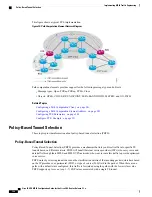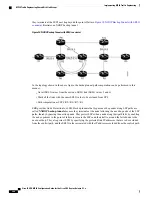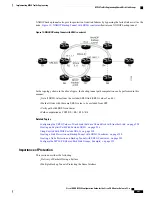
Path options for P2MP tunnels are individually configured for each sub-LSP. Only one path option per sub-LSP
(destination) is allowed. You can choose whether the corresponding sub-LSP is dynamically or explicitly
routed. For the explicit option, you can configure the verbatim path option to bypass the topology database
lookup and verification for the specified destination.
Both dynamic and explicit path options are supported on a per destination basis by using the
path-option
(P2MP-TE)
command. In addition, you can combine both path options.
Explicit Path Option
Configures the intermediate hops that are traversed by a sub-LSP going from the TE source to the egress
MPLS node. Although an explicit path configuration enables granular control sub-LSP paths in an
MPLS network, multiple explicit paths are configured for specific network topologies with a limited
number of (equal cost) links or paths.
Dynamic Path Option
Computes the IGP path of a P2MP tree sub-LSP that is based on the OSPF and ISIS algorithm. The
TE source is dynamically calculated based on the IGP topology.
Dynamic path option can only compute fully-diverse standby paths. While, explicit path option supports
partially diverse standby paths as well.
Note
Dynamic Path Calculation Requirements
Dynamic path calculation for each sub-LSP uses the same path parameters as those for the path calculation
of regular point-to-point TE tunnels. As part of the sub-LSP path calculation, the link resource (bandwidth)
is included, which is flooded throughout the MPLS network through the existing RSVP-TE extensions to
OSPF and ISIS. Instead of dynamic calculated paths, explicit paths are also configured for one or more
sub-LSPs that are associated with the P2MP-TE tunnel.
•
OSPF or ISIS are used for each destination.
•
TE topology and tunnel constraints are used to input the path calculation.
•
Tunnel constraints such as affinity, bandwidth, and priorities are used for all destinations in a tunnel.
•
Path calculation yields an explicit route to each destination.
Static Path Calculation Requirements
The static path calculation does not require any new extensions to IGP to advertise link availability.
•
Explicit path is required for every destination.
•
Offline path calculation is used.
•
TE topology database is not needed.
•
If the topology changes, reoptimization is not required.
Related Topics
Configuring Destinations for the Tunnel Interface, on page 311
Cisco IOS XR MPLS Configuration Guide for the Cisco CRS Router, Release 5.1.x
197
Implementing MPLS Traffic Engineering
Point-to-Multipoint Traffic-Engineering



































